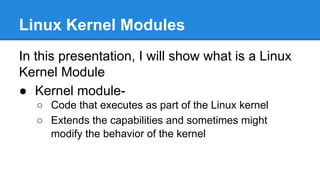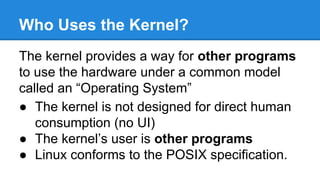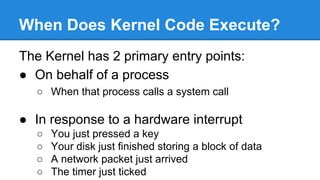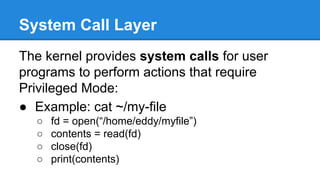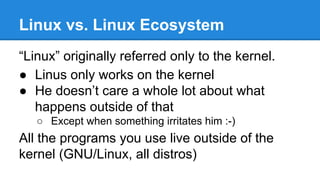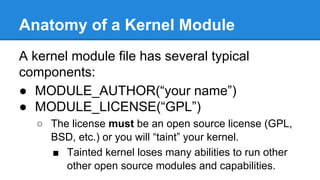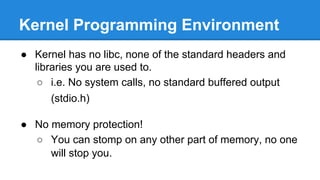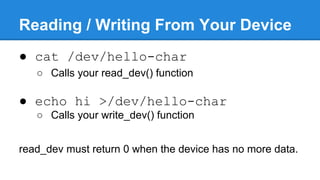Linux kernel modules
- 2. Eddy Reyes Founder of Tasqr (www.tasqr.io) In my past life: ● IBM- AIX kernel developer ● Lifesize- Linux device driver developer ● Various other non-kernel software development
- 3. Linux Kernel Modules In this presentation, I will show what is a Linux Kernel Module ● Kernel module- ○ Code that executes as part of the Linux kernel ○ Extends the capabilities and sometimes might modify the behavior of the kernel
- 4. Let’s Back Up For a Second... What exactly is the Linux Kernel?
- 5. Your Computer == Pile of Hardware Your average computer (or phone) has a quite large variety of hardware. ● CPU, Disk, NIC, GPU, Speakers, Display, RAM, DVD Drive, Game Controller, Webcam, Microphone, GSM Radio, WiFi, Keyboard, Mouse, Touch Screen, etc.
- 6. What Is the Kernel? Very simple answer: it's a program that makes your hardware look and feel like an OS to other programs Hardware (CPU, Keyboard, Disk, Monitor) Linux Kernel GNOME bash cat Chome grep
- 7. Who Uses the Kernel? The kernel provides a way for other programs to use the hardware under a common model called an “Operating System” ● The kernel is not designed for direct human consumption (no UI) ● The kernel’s user is other programs ● Linux conforms to the POSIX specification.
- 8. Hardware Protection Most modern processors protect access to hardware ● User Mode… running program: ○ Has no access to hardware ○ Has its own dedicated address space ● Privileged Mode… running program: ○ Can mess with all hardware ○ Has access to single shared global address space
- 9. When Does Kernel Code Execute? The Kernel has 2 primary entry points: ● On behalf of a process ○ When that process calls a system call ● In response to a hardware interrupt ○ You just pressed a key ○ Your disk just finished storing a block of data ○ A network packet just arrived ○ The timer just ticked
- 10. Kernel And Hardware Kernel is the middle-man for hardware access. Disk Kernel System Call cat ~/file interrupt
- 11. System Call Layer The kernel provides system calls for user programs to perform actions that require Privileged Mode: ● Example: cat ~/my-file ○ fd = open(“/home/eddy/myfile”) ○ contents = read(fd) ○ close(fd) ○ print(contents)
- 12. Linux vs. Linux Ecosystem “Linux” originally referred only to the kernel. ● Linus only works on the kernel ● He doesn’t care a whole lot about what happens outside of that ○ Except when something irritates him :-) All the programs you use live outside of the kernel (GNU/Linux, all distros)
- 13. Back to Kernel Modules Almost all problems are solved in user space programs. ● Why do we need kernel modules? ○ I have some hardware I want to make work in Linux ○ I want to create a program that resides in the kernel and runs in privileged mode ■ In practice, almost never happens
- 14. To Write a Kernel Module... ● Kernel Modules are written in the C programming language. ● You must have a Linux kernel source tree to build your module. ● You must be running the same kernel you built your module with to run it.
- 15. Anatomy of a Kernel Module A kernel module file has several typical components: ● MODULE_AUTHOR(“your name”) ● MODULE_LICENSE(“GPL”) ○ The license must be an open source license (GPL, BSD, etc.) or you will “taint” your kernel. ■ Tainted kernel loses many abilities to run other other open source modules and capabilities.
- 16. Anatomy of a Kernel Module ● int init_module(void) ○ Called when the kernel loads your module. ○ Initialize all your stuff here. ○ Return 0 if all went well, negative if something blew up. ● void cleanup_module(void) ○ Called when the kernel unloads your module. ○ Free all your resources here.
- 17. Hello World Kernel Module Example #include <linux/kernel.h> #include <linux/module.h> MODULE_AUTHOR(“Eddy Reyes”); MODULE_LICENSE(“GPL”); int init_module(void) { printk(KERN_ALERT “Hello worldn”); return 0; } void cleanup_module(void) { printk(KERN_ALERT “Goodbye, cruel worldn”); }
- 18. Kernel Programming Environment ● Kernel has no libc, none of the standard headers and libraries you are used to. ○ i.e. No system calls, no standard buffered output (stdio.h) ● No memory protection! ○ You can stomp on any other part of memory, no one will stop you.
- 19. Kernel Programming Environment ● One big single namespace ○ You have access to all “exported” symbols from your kernel module. ○ Exported functions are called “kernel services” ● Always multi-threaded ○ All modules must be thread-safe, like it or not ○ What about single-processor systems? ■ No concurrency, but Linux is a preemptable
- 20. Building Your Kernel Module ● Accompany your module with a 1-line GNU Makefile: ○ obj-m += hello.o ○ Assumes file name is “hello.c” ● Run the magic make command: ○ make -C <kernel-src> M=`pwd` modules ○ Produces: hello.ko Assumes current directory is the module source.
- 21. Running Your Kernel Module ● To manually load your module: ○ insmod hello.ko ○ Where’s our hello world message? ■ dmesg ● To unload your module: ○ rmmod hello.ko
- 22. Kernel Module Dependencies insmod/rmmod can be cumbersome... ● You must manually enforce inter-module dependencies. Modprobe automatically manages dependent modules ● Copy hello.ko into /lib/modules/<version> ● Run depmod ● modprobe hello / modprobe -r hello Dependent modules are automatically loaded/unloaded.
- 23. More Interesting Example... Let’s make a character device ● /dev/hello-char ● When you read from it, it says “hello” ● Doesn’t let you write into it Character devices are tracked by the kernel via major and minor numbers ● Major == type of device, Minor == nth device
- 24. Hello Char Device Linux Kernel uses an “ops” struct pattern that allows you to fill in behaviors via callbacks. struct file_operations fops = { .open = open_dev, .close = close_dev, .read = read_dev, .write = write_dev }
- 25. Registering Your Device Kernel Service- register_chrdev() ● Accepts: ○ Major number (0 tells the kernel to pick one) ○ Device type name (appears in /proc/devices) ○ Pointer to fops struct ● Call this in the init_module() routine
- 26. Reading / Writing From Your Device ● cat /dev/hello-char ○ Calls your read_dev() function ● echo hi >/dev/hello-char ○ Calls your write_dev() function read_dev must return 0 when the device has no more data.
- 28. Linux Device Model If you write a real device driver, don’t follow this example. Further reading: ● Linux Device Model ○ Much richer API for modules that implement device drivers ○ Integrates with udev ○ Not available on tainted kernels! ■ Must be open source to use this.
- 29. Congratulations! We’ve built a couple kernel modules together! Any lingering questions?


